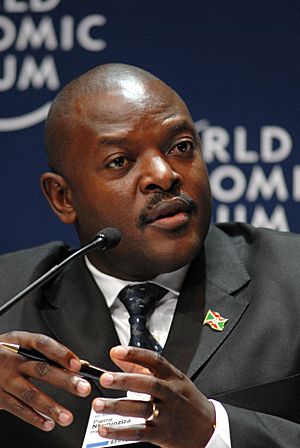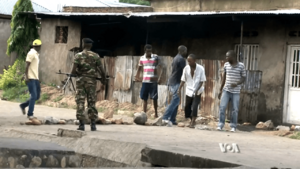Burundian unrest (2015–2018) facts for kids
Quick facts for kids Burundian unrest |
|||
|---|---|---|---|

Burundian police chasing protesters in 2015
|
|||
| Date | 26 April 2015 – 20 January 2020 | ||
| Location | |||
| Caused by |
|
||
| Methods |
|
||
| Status |
|
||
| Parties to the civil conflict | |||
|
|
|||
| Lead figures | |||
|
|||
| Casualties | |||
| Death(s) | Many people lost their lives Hundreds of thousands of people had to leave their homes |
||
The Burundian unrest was a period of protests and conflict in Burundi. It began on April 26, 2015, and lasted until January 20, 2020. The main reason for the unrest was the decision by the ruling political party, the CNDD-FDD, to allow President Pierre Nkurunziza to run for a third term. Many people believed this was against the country's constitution.
Large protests took place in Bujumbura, which was the capital city at the time. These protests lasted for more than three weeks. During this time, Burundi's highest court said that President Nkurunziza could run for a third term. However, at least one judge from the court left the country, saying he had received threats. The government also blocked internet and phone services and closed all universities. Government officials called the protesters "terrorists." Many people were arrested, and some people were hurt or killed. Tens of thousands of people also had to leave Burundi.
On May 13, 2015, a group of military leaders tried to take control of the government. This happened while President Nkurunziza was in Tanzania for a meeting about the situation. But the very next day, the attempt to take over failed, and government forces regained control. Later, in December, nearly 90 people were killed in attacks on government buildings.
Why the Unrest Started
Burundi's Past and Poverty
Burundi had a long and difficult Burundian Civil War from 1993 to 2005. About 300,000 people died during this war. After the war, a peace agreement led to a new constitution in 2005. This constitution made sure that both Hutu and Tutsi groups had a fair say in the government. Pierre Nkurunziza, from the Hutu FDD party, became president.
Even after the war, poverty remained a big problem in Burundi. More than 60% of Burundians did not have enough food, according to the World Bank. The government also struggled to find enough money for important programs. Burundi's economy relies a lot on coffee exports. The price of coffee has changed a lot over the years, making it hard for the country to plan its finances.
Rules About a Third Term

On May 4, 2015, a judge from Burundi's highest court, the Constitutional Court, left the country. He said he received threats from government officials. This judge claimed that most of the seven judges on the court believed it was against the constitution for Nkurunziza to run again. Even the United States Secretary of State, John Kerry, said that Nkurunziza's plan went against the constitution.
After four of the seven judges left, the remaining judges approved Nkurunziza's right to run for a third term. People who opposed the president said that the court's decision was "manipulated."
Critics of the president said his actions put the peace deal at risk. This deal had helped keep peace between different ethnic groups since the civil war ended in 2005. They argued that the constitution did not allow Nkurunziza to seek a third term. However, his supporters argued that his first five-year term should not count. They said this was because he was chosen by a vote in parliament, not by a direct vote from the people.
Protests and Uprising
First Week of Protests
On April 25, 2015, the ruling CNDD-FDD party announced that Nkurunziza would run for president again in the June 26, 2015 election. This news caused protests. People who were against Nkurunziza said that a third term would break the country's constitution. The constitution states that no president can be elected more than twice.
In the capital city of Bujumbura, protesters blocked roads by cutting down trees. After several days of protests, President Nkurunziza met with an American diplomat on April 30. He told the diplomat that the protests were against the law.
On May 1, a grenade attack in Bujumbura killed three people, including two police officers. Human rights groups reported that protesters had been beaten and arrested. On the same day, President Nkurunziza gave a speech. He repeated that the protests were illegal. He also said that a committee would be formed to investigate. He warned that "severe actions will be taken" against anyone found guilty of illegal activities.
On May 2, the Security Minister, General Gabriel Nizigama, called the protests an "uprising." He said that the demonstrators would be seen as "criminals, terrorists, and even enemies of the country."
The International Red Cross reported that at least six people died in the demonstrations. A spokesperson for the Office of the United Nations High Commissioner for Human Rights said that over 400 protesters were arrested. Some of them were beaten in prison.
Second Week of Protests
Protests started again on May 4, after a two-day break requested by protest leaders. The protests began peacefully. However, at least two protesters were shot and killed by police after stones were thrown at officers.
Attempted Takeover by Military
On May 13, 2015, Major General Godefroid Niyombare announced that he was taking over the government. He said on the radio that "Nkurunziza is dismissed, his government is dismissed too." This happened while President Nkurunziza was in Tanzania. Niyombare, who used to be the army chief, made the announcement with other senior army and police officers. After his announcement, crowds in the capital celebrated. Soldiers were seen guarding the main state TV and radio building.
President Nkurunziza tried to fly back to Burundi, but his plane was reportedly turned back to Tanzania. News reports said that rebel soldiers had taken control of Bujumbura International Airport. However, the head of the armed forces, Prime Niyongabo, announced later that night that the takeover attempt had failed. He spoke from the state radio complex and told rebel soldiers to give up. Forces loyal to the government kept control of the state radio and the presidential palace. Soon after, there was heavy fighting around the state radio complex as rebel soldiers attacked it. But the station remained in the hands of loyal forces.
A journalist at the state broadcaster reported "heavy gunfire" around the station. Witnesses also said that two private radio stations, which had broadcast Niyombare's announcement, were attacked by men in police uniforms. One station, Radio Publique Africaine, was set on fire. Five soldiers were reported killed in clashes. The government said it had regained control of the sites.
The chairperson of the African Union, Nkosazana Dlamini-Zuma, strongly condemned the takeover attempt. She called for a "return to constitutional order" and asked everyone to act calmly. Nkurunziza thanked the loyal soldiers and said that rebel soldiers would be forgiven if they surrendered.
In the hours after the failed attacks, the takeover attempt seemed to fall apart. Later on May 14, Nkurunziza announced that he had returned to Burundi. He thanked the army, police, and the Burundian people. One of the leaders of the takeover, General Cyrille Ndayirukiye, said that "our movement has failed." He also suggested that soldiers supporting the takeover would not continue fighting. He said the leaders did not want to be responsible for leading their followers to their deaths.
Early on May 15, Niyombare said that he and the other leaders had decided to surrender to government forces. Meanwhile, Nkurunziza returned to Bujumbura. He said on state radio that there was "peace in the whole country." He promised that anyone trying to cause trouble would fail. The government also said that Niyombare was still free, which was different from an earlier statement that he had been captured.
On May 16, eighteen people appeared in court. These included former defense minister General Cyrille Ndayirukiye and police commissioners. Their relatives claimed they had been beaten while in custody.
On May 18, President Nkurunziza removed three ministers from his government. These were the Minister of National Defence Pontien Gaciyubwenge, Foreign Minister Laurent Kavakure, and Trade Minister Marie-Rose Nizigiyimana.
Images for kids





